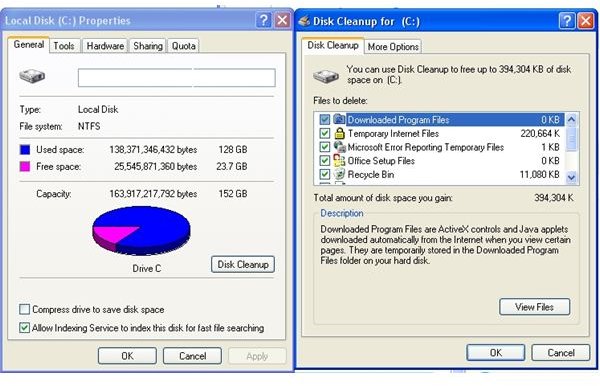How to Defragment a Hard Drive & Remove Unused Files to Speed Up Your Computer
The Disk Cleanup Utility
While the Disk Cleanup Utility, on its own, may not increase the speed of your computer, it is an important tool to use when taking steps to boost your computers performance and speed. Windows computers require you to constantly have free space on your hard drive - 15 gigabytes or more! As you can see, every megabyte counts, and the Disk Cleanup tool can help. It identifies useless and/or unwanted files and removes them in one fell swoop.
Pull up the My Computer window, from either the Start menu or an icon on your desktop. Right-click your hard drive (probably labeled C:) and select “Properties”. In this screenshot you can see that my disk is rather full, so reclaiming some space is in my best interests. Click on “Disk Cleanup”, located to the right of the pie chart. It will take a few moments for Windows to calculate how much space you can reclaim. Select what you want to be included, then click OK to remove the excess files. As you can see, I reclaimed 1/3 of a gigabyte of space!
The Disk Defragmentation Utility
Following this guide, you have probably rid yourself of a lot of excess files and other junk. You have probably heard that you need to “defragment your hard drive” on a regular basis, but do you really know what that means? It sounds important, even fancy and technical, but it is really a straight-forward process that is critical to the health of your computer. You might be surprised that the way you see your files organized in Windows has absolutely nothing to do with how they are organized on the physical disk. The disk just fills up space in a linear fashion - from one edge to the other, so to speak. When you delete a file, that space becomes available. The next file that is added to the disk may be bigger than the last one you deleted, and it will split itself among open spaces. Over time, this causes the disk to become that scary technical word - fragmented! When you defragment your hard drive, you are simply regrouping files together the way they should be so that your computer doesn’t have to work so hard to find all the pieces.
1. Right-Click My Computer and select “Properties” again. This time, click on the “Tools” tab.
2. The second option down from the top is the Defragmentation Tool. Click “Defragment Now”. This will bring up the tool.

Click “Analyze” so see if your disk needs to be defragmented. It may take a few moments. A message will pop up telling you what to do. As you can see, my disk needs to be defragmented.
3. Click “Defragment”, and you system will begin the process. This may take some time, but will increase the overall speed of your computer.
This post is part of the series: Make Your Computer Faster
Quick, easy tips to making your Windows computer run like the day you bought it. Speed up your computer with these do-it-yourself suggestions and step-by-step guides.
